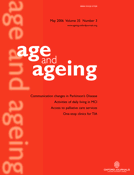-
PDF
- Split View
-
Views
-
Cite
Cite
Richard W. Bohannon, Grip strength predicts outcome, Age and Ageing, Volume 35, Issue 3, May 2006, Page 320, https://doi.org/10.1093/ageing/afj061
Close - Share Icon Share
Sir—I was pleased to read the Research Letter of Kerr et al. in the January issue of this journal [1]. In it, they report a relationship between the grip strength and discharge disposition of elders admitted to hospital. Their research, though informative, is not the first to investigate ‘the link between grip strength and outcome in non-surgical settings’. For a primarily aged cohort of patients hospitalised with pneumonia, we have reported a significant correlation (−0.226) between the grip strength and a ‘bad acute outcome’; that is, an in-hospital death or a length of stay of nine or more days [2]. We also found grip strength to correlate significantly with the length of stay (−0.269), discharge home (0.545) and 30-day survival (0.285) [3]. In a follow-up study, we showed that death within a year of hospitalisation was correlated with grip strength (−0.272) [4]. Grip strength was a stronger predictor than any other measured variable, including pneumonia severity, co-morbidity load, age or preadmission residence in an extended care facility.
Considering Kerr et al.’s results in combination with our own, I would definitely agree that grip strength should be measured routinely ‘alongside the measurement of blood pressure’ [1]. Grip strength and other physical performance measures can ‘serve as easily accessible “vital signs” to screen older adults in clinical settings’ [5].




Comments